
section shines a light on veterans ahead of holiday Page 11
Two elected early Two councilmembers certified after one candidate dropped out Page 20
Stone Ridge Veterinary Clinic FAMILY OWNED &
Dear Santa Please bring us Treats Toys Brushes










section shines a light on veterans ahead of holiday Page 11
Two elected early Two councilmembers certified after one candidate dropped out Page 20
Stone Ridge Veterinary Clinic FAMILY OWNED &
Dear Santa Please bring us Treats Toys Brushes








By Katherine Weinstein | k.weinstein@mycityjournals.com
After 65 years in business, Draper landmark Ballard’s Iceberg Drive-In closed its doors on Oct. 4.
The timeworn proverb, “All good things must come to an end,” rang true for many in Draper last month when Ballard’s Iceberg Drive-In closed its doors after 65 years in business.
Owner Don Ballard explained that he is ready to start a new chapter in his life. “We’ve been open for 65 years and I’ve been managing it for 55,” he said. “Not many of my friends have worked at one job that long, seven days a week. I’m going to be 75, figured it was time.”
While Ballard will retain ownership of the property, the Iceberg and the small house behind it will eventually be demolished to make way for a Jiffy Lube. “There’s nobody to pick up the reins,” he said of the eatery’s closing, explaining that his children and grandchildren have careers of their own.
“I’ve been doing this for so long,” Ballard said, adding that he and his wife, Deb, hope to spend some of their retirement years traveling.
Deb appreciates that the Iceberg is a special place for many in the community. When she was growing up, her family stopped in for a treat whenever they were in Draper. At the same time, she is ready for a change. “I am looking forward to Don not having to get up before 6 a.m.,” she said, “I’m happy for him.”
Ballard’s mother, Alice Mae, opened the Iceberg in 1960. At the time, the small burger and shake stand was surrounded by farm land. The Ballard family lived in the home behind the Iceberg and worked there in various capacities over the years. “Dad did steel work,” Ballard recalled. “He opened up on Saturdays.”
Don, the youngest of three brothers, took over as manager in 1976 but Alice Mae stayed active working at the Iceberg. “In her

early 80s, she would run errands and still come in,” he said.
The Iceberg had a distinctive, zig-zag shaped roof when it first opened and there was no seating. The building was later enclosed and small booths were added. As word about the Iceberg’s imminent closure spread, people reached out to Ballard asking about acquiring a booth as a memento. The place holds memories for many in the community.
“Sixty-five years can accumulate a lot of history,” Ballard said. He reminisced a bit about a lifetime of family and community at the Iceberg. He spoke of his dad working the
counter and about the time his brother caught his tie in the soft serve machine right before a date. He shared his memories of a customer who proposed to his girlfriend in one of the booths and the kids skipping church who came by on Sunday mornings, drawn by the candy counter that used to be there.
As Draper grew and fast food franchises moved in, Ballard managed to keep the place going. “We kept doing what we do,” he said. “The demographics have changed, but we still have quite a few people who have been coming in over the years.”
The burgers, fries and shakes, all made
with locally-sourced ingredients, kept customers coming back for decades as did the familiar faces behind the counter.
Julie Mitchell brought her mother to the Iceberg for one last malted milkshake before closing day. Mitchell worked at the Iceberg in the 1970s. “It was my very first job,” she said. “I got to work with Alice Mae and Don. Alice Mae would see people and just know what they wanted before they ordered. And Don joked with everybody.” Mitchell recalled making sure that each milkshake towered over the top of the cup
Continued on page 4










Our team is expanding to provide faster, more comprehensive care that’s close to you. We provide:
› Care for your heart: We diagnose and manage heart conditions including high cholesterol, high blood pressure, heart attacks, and more
› Echocardiograms: A safe, painless test that shows how your heart is working
› Stress testing: See how your heart performs when it’s working hard
› Heart Rhythm Monitoring: Find and treat problems with your heart’s electrical system
Life can change in a heartbeat. We want to help you keep it going.
Scan the QR code for more information or call (801) 507-3500 to schedule an appointment at one of five locations.
Locations
Cardiology Clinic at Intermountain Medical Center 5169 South Cottonwood Street, Ste. 520 Murray, Utah 84107
Cardiology Clinic at LDS Hospital 8th Avenue C Street, 6th Floor Salt Lake City, Utah 84103
Cardiology Clinic at Alta View Hospital 9450 South 1300 East, 4th Floor Sandy, Utah 84094 Cardiology Clinic
and chopping the lettuce and onions by hand. “It’s just sad to see one of the original places in Draper close,” she said.
The Iceberg held a closing party with live music Oct. 4 which was packed with patrons wanting to say goodbye.
Former Utah State Rep. LaVar ChrisContinued

When this photograph of Ballard’s Iceberg Drive-In was taken shortly after its opening in 1960, the burger and shake stand was surrounded by farm land. (Photo courtesy of Don Ballard)
tensen remembered the Iceberg as one of the few businesses in town when he first moved to Draper in 1989. “It isn’t just one thing or one person,” he said, “it’s the history of our town. We want to say thank you.” l

Alice Mae Ballard opened the Iceberg Drive-In with her husband, Allen, and managed it for many years. (Photo courtesy of Don Ballard)



The Draper Journal is a monthly publication distributed directly to residents via the USPS as well as locations throughout Draper.
For information about distribution please email hello@thecityjournals.com or call our offices. Rack locations are also available on our website.
The views and opinions expressed in display advertisements do not necessarily reflect or represent the views and opinions held by Loyal Perch Media or the City Journals. This publication may not be reproduced in whole or in part without the express written consent of the owner. © 2019 Loyal Perch Media, Inc.
PUBLISHER
Bryan Scott | bryan.s@thecityjournals.com
EDITOR
Travis Barton | travis.b@thecityjournals.com
ADVERTISING EXECUTIVES
Mieka Sawatzki | mieka.s@thecityjournals.com
Lindsay Andreasen | lindsay.a@thecityjournals.com
Jason Corbridge | jason.c@thecityjournals.com
Ryan Casper | ryan.c@thecityjournals.com
Marc Davis | marc.d@thecityjournals.com
Rack
Lydia Rice | lydia.r@thecityjournals.com 385-557-1022
Stacey LaMont Ty Gorton DRAPER CITY JOURNAL 9500 South 500 West, Suite 205 Sandy, UT 84070
PHONE: 801-254-5974
& Distributed by


Our favorite big box stores and online ads have been reminding us for weeks that the holidays are just around the corner. Happy time, right? Surprisingly the holidays can be a time of increased stress and can trigger mental health challenges for many. A 2023 survey by the American Psychological Association found that 89% of U.S. adults feel stressed during the holidays, with more than one-third indicating they experience higher stress levels during the holidays compared with other seasons. Added holiday stress can cause physical ailments, anxiety, depression, and in some cases substance misuse.
So what’s the holiday stress culprit? Well actually there are several:
Money. The holidays create budget pressures – gifts, travel, events.
Social. Family gatherings can produce awkward moments, especially when there are unresolved conflicts or pressure to follow tradition.
Busyness. Schedules can become overloaded with shopping, cooking special meals and attending holiday festivities. Sometimes with all the extra activity and disrupted routines, the holidays can be exhausting.
Loneliness. The holidays can create a heightened sense of loneliness for those who are separated from loved one or grieving a loss.
According to Dr. Jared Lambert, a CommonSpirit family medicine physician in West Jordan, there are several things we can do to manage holiday stress and even find joy in a season that is meant to be joyful.
First – Set realistic expectations. You may not cook the perfect turkey. The gift that you spent hours searching for may not elicit the magical reaction from the recipient. You may not be able to attend all the holiday events you’re invited to. That’s OK.
Second – Make time for yourself. Carve out a few moments each day during the holidays to read, get outside, meditate, and remember that the basics of self-care



– sleep, exercise, and healthy eating – still matter at this time of year.
Third – Set a budget. Having a financial plan going into the holidays helps with avoiding excessive spending. There’s nothing quite so deflating as January credit card bills that exceed what we can afford.
Fourth – Find joy in small things. Make time to talk to a friend or family member who makes you feel good. Savor that favorite side dish at Thanksgiving Dinner, listen to a favorite holiday song – and look for reasons to be grateful each day.
Fifth – Take a time out from Social Media: By limiting time on social media feeds you can reduce feelings of inadequacy by avoiding depictions of others’ perfectly curated holidays.
“The holidays can be a beautiful time, but they can also bring to the surface a lot of underlying stressors,” Dr. Lambert says. “It’s crucial to be honest with yourself about how you’re truly feeling and to allow for imperfections. Prioritize your well-being over societal pressures to create a ‘perfect’ holiday.”
If you find yourself severely struggling, reach out for help. Talk to a trusted friend, call a helpline, or visit a mental health professional.
For more information or to find a provider visit mountain.commonspirit.org


Learn more about the services, care providers and missiondriven work of the Holy Cross hospitals and CommonSpirit Health at www.holycrossutah.org.

advance social justice for all.
When you need emergency care fast, the closest emergency room is a smart thing to know. You never know the level of care you’ll need when an emergency happens and choosing the right ER can make all the difference. And a hospital ER comes with the confidence of additional services right on-site.
CommonSpirit Holy Cross Hospital – Salt Lake has been awarded Chest Pain Center Accreditation from the American College of Cardiology (ACC). Facilities that achieve accreditation meet or exceed an array of stringent criteria for evaluating, diagnosing and treating patients who may be experiencing a heart attack.
Find emergency care close to you at mountain.commonspirit.org.
Draper’s library attracts 13,000 visitors every month with a plethora of programs and materials, and the library is celebrating its 20th anniversary.
By Mimi Darley Dutton m.dutton@mycityjournals.com
The year was 2005. Hurricane Katrina devastated Alabama and Louisiana, especially New Orleans. More than 1,800 people died and damage was estimated at $108 billion. The United States was fighting wars in Iraq and Afghanistan. “Madagascar” was in movie theatres. “The Office” debuted on television. YouTube debuted online. Lance Armstrong won his seventh straight Tour de France before later being disqualified and banned from cycling for doping. And the Draper Library opened its current location.
To celebrate, the library hosted a 20th anniversary party Aug. 16, with special activities inside and outside. The building was a little noisier than usual, but per usual, all ages and walks of life came through the doors to enjoy all the library has to offer. County statistics show some 13,000 people visit the Draper Library every month.
Katie and Dallin Hunter brought daughters Jane and Lucy to the library that Saturday, not knowing the celebration that await-
ed them. “We come at least a couple times a month,” Dallin said. Katie grew up in Davis County where she had access to a bookmobile. “Coming to the library is the next best thing. We’re big readers,” Katie said.
Outside featured a kiddie pool where people could “fish” for prizes. Inside, background music from 2005 played, including Daniel Powter’s “Bad Day” song, and 2005 national and local trivia scrolled on the big screen TV in the large conference room recalling Jon Huntsman Jr. was Utah’s governor, the University of Utah won the Fiesta Bowl, and the San Antonio Spurs were NBA champions.
Several indoor activities were nods to the city’s history as the “Egg Basket of Utah,” back when Draper’s eggs were shipped nationwide, even to WWII soldiers. Participants could make a chicken paper craft and a train coloring craft. “That’s how the eggs got around the country,” librarian Sherry Ann Lee explained.
Ruth and Claire Hanks had flowers painted on their faces as part of the festivities. The sisters enjoy riding their scooters to the library and cooling off as they peruse the books and play games.
A large poster asked patrons “Why do you love the library?” People wrote answers such as “we like coming to the puppet shows,” “I love reading” and “the fireplace

for a cozy reading environment.” One person wrote, “I used to walk to the library with my friends in the summer and we would love to find new books. Now I bring my little ones.”
In the main library, a “Flashback to 2005” display still stands, offering popular movies and books from that year that can be checked out. Maybe you remember “The Year of Magical Thinking” by Joan Didion, “The Memory Keeper’s Daughter” by Kim Edwards or “Freakonomics” by Levitt and Dubner? Or the kids’ book “Llama Llama Red Pajama?” Or maybe 2005 movies like “Robots,” “Batman Begins,” and “Star Wars: Revenge of the Sith” bring back fun memories.
Prior to 2005, the library was located in the basement of the historic Park School, a far cry from the current light-filled, LEED certified location built with an ongoing emphasis on energy and water efficiency, sustainable materials and sourcing, and accessibility. In addition to the prestigious LEED certification, the library honors Draper’s “Egg Basket” history with public art featuring chickens and a train theme throughout the kids’ area.
The library offers programs for kids, teens and adults, including services for people with disabilities. It also offers public computers, printing, faxing, copying and 3D printing.
A large poster invited patrons to write a response to the question. “What will the library be like in 20 years?” Answers included: “Moving bookshelves with buttons,” “all books available in digital format” and “bigger and better.” l



State’s top educator remains agile during shifts in education reform.
Weekone didn’t go as expected. Utah’s new State Superintendent of Public Instruction Molly Hart faced an unexpected challenge when President Donald Trump’s administration froze education funds that were set to be dispersed.
“It was surprising he froze funds that had already been approved through Congress,” she said. “I was anticipating changes, but I was anticipating them moving forward. So, when those changes happened a week into my tenure, it threw a wrench in the kickoff.”
Hart, who previously served as executive director of Summit Academy Schools for two and one-half years, hadn’t planned to follow in the footsteps of former superintendent Sydnee Dickson, who served for nine years. At Summit and as vice chair of the Utah State Board of Education, she felt she had found her place—working directly with students and leading through change.
“When opportunity comes, you got to answer the door,” said the veteran educator from Sandy. “I didn’t ever really see myself leaving a school setting where there were kids and I could be involved in an actual school day. I thought I hit the sweet spot, but opportunity knocks and to make a difference at this level, and to make things happen, how do you turn that down? It’s an exciting opportunity.”
It’s now been two months since Hart, a former teacher who served as principal at Mt. Jordan and Albion middle schools, was sworn in as state superintendent. She and Dickson collaborated to ensure a smooth transition in June into the K–12 summer break.
“I stay moving from 7 a.m. to 7 p.m. I haven’t even unpacked all my boxes. It’s back to school for USBE, just as it’s back to school for schools,” Hart said.
City Journals posed questions to Hart about key initiatives and pressing issues in education.
What was it like when the government froze funds?
The president was clear about his priorities all the way along. We did eventually get those funds, so districts are able to pay
their summer programs’ and afterschool programs’ people.
A central tenet of Trump’s plan is to eliminate the federal department of education. Is it going to impact some of the programs, such as Title I schools and others?
There are three big federal education programs: the free and reduced lunch program, the Title I program and IDEA (Individuals with Disabilities Education Act) or special education. USDA already co-manages the lunch program along with department of education. The plan for the others, at one point, was to move them to other agencies, and the funding was to continue in some form. But other Title programs, like Title II (supporting effective instruction), Title III (language instruction for English learners and immigrant students) were the ones that were frozen. We’re now looking at the budget process moving forward for when we get federal funds. There are a lot of different timelines that intersect, and the U.S. Senate pushed back against some of the president’s proposals, so it’s just an evolving story with a shifting landscape. We have to stay agile, consider the information we have at any given time and be ready to improvise.
If the federal department of education fades away, is Utah OK to run our education system?
Many people don’t think it will completely fade away. The department of education may still exist, but it could be much smaller in size and scope. It would take congressional action for the department to “disappear.” Saying that, it was nowhere on my bingo card that funds would be frozen. And, there was nowhere on my bingo card that those funds would be unfrozen. What’s extraordinary about these times is the different paths and the uncertainty of the next action. The best thing I can do is help others prepare for contingencies. Utah is well positioned to manage and keep consistent educational opportunities for kids. The problem is always where the money comes from, when the money comes, and how the money comes, so whether it comes from the state or from local, or from federal, and how it comes, what kinds of strings are attached, what kinds of choices we get to make, and how it’s administered. It’s a new game — and all those spaces are changing at the same time. At the end of the day, our teach-


ers and principals are going to open schools this fall, and they are going to give students the best education out there.
Share your top priorities.
It’s important to me that we get the various constituents together. There’s been a fracturing of communication in education, and we’ve become very polarized needlessly. As state superintendent, I can bring disparate groups of people together and create synergy. It’s important the USBE is responsive, efficient and meeting the needs of the various stakeholders and also, communicating accurate data and information to the legislature, to the field and throughout the agency. It’s important we find ways to increase student achievement and knowledge and students come away knowing how to solve problems and knowing how to meet the needs of communities in the future. That is our goal and it’s important to me that stakeholders come together and keep that in our sights. We’re an agency of the government. We serve the people. We are servant leaders. We need to do that efficiently and without wasting resources, and we need to do it transparently.
Utah has 70,000 students. Many teachers and principals are concerned about low attendance. How can USBE help?
Attendance is one of those things that can’t be solved with any one single approach. We’ve got to engage families and parents and understand why students aren’t coming to school and figure out where that disconnect is, and work on the experiences in school so that it’s a place students understand the need and what they get out of being there. It’s got to come from not just the education community, but communities at large and at the individual level. It is individual students and their
parents making a choice each day whether or not they’re going to attend. We’ve got a toolbox to support districts as they identify barriers and work to remove them. As a former principal, I do know there’s a lot a school can do, but I also understand the limitations of what a school can do and where a district or a state agency or the legislature or a community agency can have considerable impact on student rights and attendance rates. One thing we can do is look at schools at higher attendance rates and figure out what’s different between those and schools where attendance is an issue. There’s just a lot packed into attendance. It’s not simply missing a resource like a textbook. We need to look at everything. Does it have to do with transportation? Does it have to do with illness? Does it have to do with online learning? Is it a family priority or is there a barrier? Could it also be a data issue? There are a lot of questions to be answered.
What are some challenges facing our students in schools?
The changing workforce and what the workforce is going to need and what students are going to need to be prepared for the workforce is a challenge. Education spends a lot of time working with workforce, higher ed and workforce services industry partners to understand their needs, what they’d like to see our graduates be equipped with. A couple years ago, students were studying computer programming or data science and there were 1 million jobs. Well, here comes AI, and maybe some of those pieces can be outsourced, and the data scientist needs to have a whole different set of skills. That rate of change is accelerating, so it’s always a moving target. There’s a lot of movement of students geographically and making sure students information get from point A to point B safely, so there’s continuity
in services and students can pick up where they leave off, pick up in one place where they leave off in another. That’s a challenge as well.
You have said as an educator, you love hearing from parents, getting feedback and having those conversations. How are you going to do it now?
I’m working on creating listening groups and listening tours. As the school year gets started, I’ll be traveling around, coordinating and attending focus group meetings, along with state board members and legislators and community partners and districts, intentionally hearing those (parents’) voices and asking those questions. My plan is to ask the local legislators, the local board members and the state board member to be part of it and make sure as many people want to attend, can attend. There would be two meetings in the same community — one to listen to parents and hearing what they have to say, and then a second, listening to teachers and educators to get feedback there. (Once set, the schedule will be posted on the USBE website and communicated through local districts and through school community councils.)
Utah spends less than $10,000 per student (ranked last in the country). Is more needed? If so, how are you going to get more and what is it needed for?
That is a huge question. We have to live within our means and if that’s what we get, then that’s what we get. We can’t spend more.
Of course, we could use more, but it’s government money, which means it came from the people, so every time we ask for more, we’re asking people for it from their wallet. What’s most important is that we’re using the money we do have in the best way possible. I can ask, ‘What are we getting for the money that we do spend? Are there things we’re spending more on, that maybe were needs of the past, but are not current needs?’ We need to make sure money is going to the right places. We want to use the money we do have in the best way possible for the best outcome to set up our students for success, whatever success looks like for them and their families.
Utah students are pushing graduation rates close to 90%; how does that compare to national standards?
It’s amazing. When I go to national activities or conferences or gatherings, Utah has the envy of a lot of states. At a national conference, one of our staff members shared our teacher retention rate (91% average retained in a single year) and people in the room gasped. We are doing really great things in Utah and I’m proud of the work we do in our communities and at our state level, but you just don’t settle. You just don’t. We’re going to keep on doing great things for our kids and as new situations and new realities emerge in our communities and in our workforce, then we adjust our practices accordingly. We keep looking forward for those opportunities and those teachable moments.
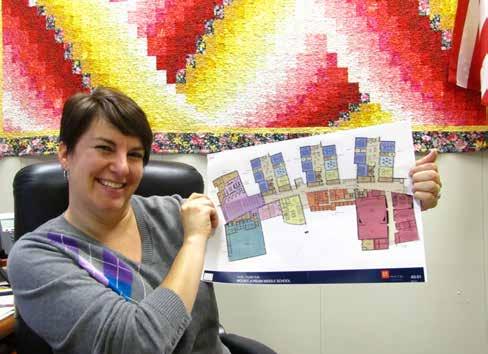
Utah is ahead of the national average on test scores. Can Utah students do better?
I’m very proud of the work our families and students do. Of course, we can do better, and, of course, I want them to do better and I’m going to push them to do better. There’s always room to grow. I like to be a little re-
lentless with pushing everyone to be better; we don’t ever quit on kids. We keep moving forward and putting one foot in front of the other. I’m never going to say, ‘We’ve arrived’ and ‘It’s good enough.’ l





























When clinical psychologist Katie Fry, Ph.D., recognized that the military veterans she counsels needed more community support and opportunities to socialize, she decided to do something about it. Two years ago, she founded Warrior Revival, a Utah-based nonprofit that supports veterans and their families’ transition to civilian life through recreation opportunities, mentorship and retreats. Among the many social activities offered by the organization is a monthly book club that meets in Draper.
“When we first started, we thought we’d have one activity per month,” Fry explained. “It has just taken off. We now have 10 to 12 activities per month. Everything is free and it’s all run by volunteers.”
She noted that veterans who return to civilian life face unique challenges when they leave the military. “I see it through my patients,” she said. “There’s a loss of community and sense of meaning and connection. We want veterans to feel safe and supported.”
To that end, Fry started Warrior Revival as a way to bring veterans and civilians together. “We try to partner with organizations in the community,” she said. “The goal is to give back and break down barriers.”
Currently, over 500 veterans from throughout Utah have participated in Warrior Revival events and activities. “We’ll have between five and 20 meet up for coffee hours and the book club,” she said. Over 100 signed up for the Hook & Honor Warrior Fishing Classic that was held at Strawberry Bay Marina last September.
Other activities the organization has sponsored include scuba diving opportunities, hiking and biking trips, a whitewater rafting retreat and off-roading excursions. All of these events are made possible thanks to corporate sponsorship and foundation support. “We really rely on fundraising,” Fry said. “We rely on the


community to help us.”
In addition to the larger events, Warrior Revival members also gather for coffee hours and a monthly book club. The book club meets after business hours at Houzd Mortgage, 11550 S. 700 East, in Draper. Brandy Tilo, a realtor who served in the Navy, initiated the book club last year. “It kind of morphed into Warrior Revival,” she said. “We just got more and more veterans but anyone can come.”
Tilo explained that while some of the books they have read specifically address how to transition from the military, other books contain life lessons with more general appeal. “We read ‘The Let Them Theory’ by Mel Robbins and books by David Goggins,” she said.
“It’s funny how we end up,” she added. “There is a lot of crying and a lot of laughter. It’s become almost a self-help therapy session.”
The meetings, which start at 6 p.m., usually begin with a little socializing before the club members share their thoughts and perspectives on the book. They then collaboratively select a book for the next month.
“I never thought I’d get so much out of a book club,” Tilo said. “I look forward to that last Tuesday of the month.”
The Warrior Revival book club is made up of both men and women of all ages. “It’s a very mixed bag. Not all are military but I think that’s even better, we get different perspectives,” she said.
“We average about seven to eight people in the club,” Tilo said. “It’s our safe space so we don’t want it to get too big. But we certainly have room for more. It really is a good time.”
Fry emphasized that Warrior Revival serves all veterans. Recently, the organization hosted a virtual get-together and a lunch meeting just for women. “We are working on adding space for women to come together,” she said.
“We truly welcome everyone to join our community,” she said. “We welcome those who want to give back to our service members — those veterans and their families who have selflessly given so much to us.”
To learn more about Warrior Revival, visit warrior-revival.org.

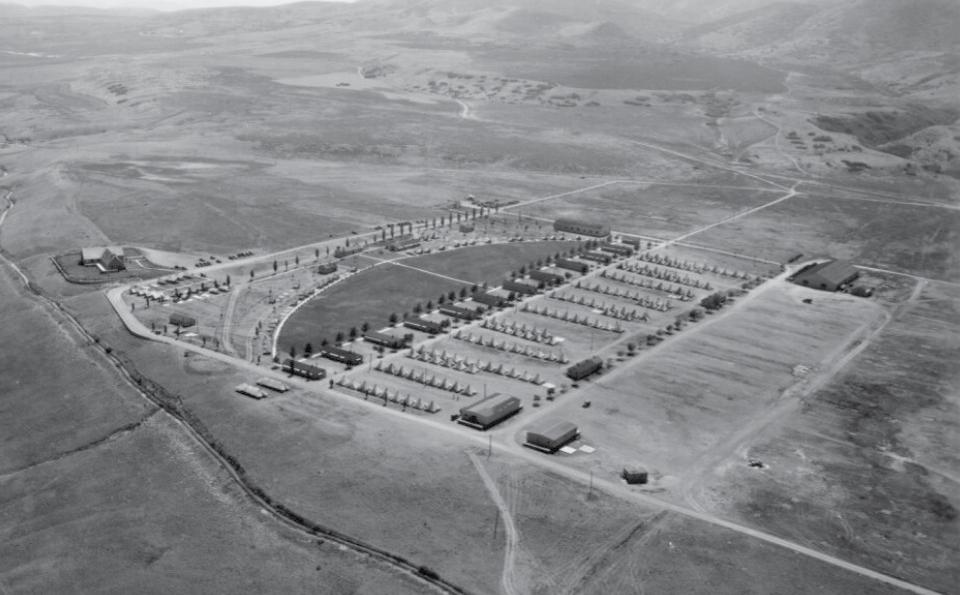
than
By Elisa Eames | e.eames@mycityjournals.com
On July 25, a fun adventure turned into a harrowing ordeal for a man who was hiking near Idaho’s Leatherman Peak. While negotiating the rough landscape, he fell and sustained severe injuries, including compound fractures in both legs, stranding him at an extremely high altitude. Knowing that Utah Army National Guard teams receive specialized high-altitude training at Camp Williams, the state of Idaho asked Utah for help that evening.
“Due to the extreme altitude, low moonlight and rugged terrain, local search and rescue personnel were struggling to reach the stranded hiker,” the 97th Aviation Troop Command said in a statement. The 97th Aviation Troop Command is the brigade headquarters, or the
unit overseeing the command and administration of a brigade, for Utah National Guard Aviation Battalions, including the 2-211th General Services Aviation Battalion, which supplied rescue volunteers.
In an HH-60M Blackhawk helicopter equipped with just the kind of rare machinery the situation demanded, a West Jordan-based medical team of volunteers from the 2-211th General Services Aviation Battalion began its hurried flight to Idaho. Following a stop in Idaho Falls to refuel, the team was able to locate the hiker in near pitch-black conditions after reaching his last known position.
“[They] conducted an extremely difficult and technical hoist operation, lowering their on-board medic onto the steep terrain to begin immediate care of the

hiker,” the 97th Aviation Troop Command said.
When the medic was able to stabilize the man, the helicopter used a hoist cable to bring him on board while hovering in mid-air. The operation took place at approximately 10,500 feet above the average sea level. The hiker continued to receive lifesaving medical care as the Blackhawk sped to meet a waiting civilian emergency transport helicopter, which transferred him to a medical center.
“This is a mission that the Citizen-Soldiers of the Utah Army National Guard are uniquely qualified for and stand ready to conduct at a moment’s notice,” the 97th Aviation Troop Command said.
Many locals don’t realize that the training that makes rescues like this possible happens in our own backyard. “All units within 97th Aviation Troop Command train at Camp Williams routinely as a primary training site for members of the Utah National Guard,” Tamara L. West said. West is the public affairs officer for the Utah National Guard, which was organized in 1894.
Camp Williams was established in 1914 as a training ground for the National Guard during World War I, though it was a fraction of its current 24,063 acres and hadn’t yet received its official name. In 1927, permanent and semi-permanent structures were built on the site, and a year later, the camp was named for Brigadier General William Grey Williams to recognize his role in founding the training location and for his service in the Spanish-American War.
The camp continued to grow, and after the bombing of Pearl Harbor in 1941, the U.S. Army took control of the complex, using it as a main training center for
active-duty troops. Oversight of Camp Williams was returned to Utah in 1947, and since then, it has played an important role in training troops who would serve in Korea, Vietnam, the Cold War, the Persian Gulf, the War on Terror and even during the state’s COVID-19 response.
Today, the camp provides extensive combat and rescue training for the Utah National Guard, serves active-duty and reserve soldiers and hosts youth and civic groups. It also supports civilian, federal and state entities, including local, state and federal law enforcement organizations. The 97th Aviation Troop Command even executes flyovers for Provo’s annual Stadium of Fire celebration.
“The Utah National Guard performs missions at the request and approval of our governor and trains [at Camp Williams] to support our state and civil authorities in a wide range of capabilities,” West said. “[It] regularly supports our state and communities with wildland fire support, technical rescue, debris removal and hazardous materials monitoring and assessment…”
“Herriman City values its longstanding partnership with Camp Williams and the Utah National Guard,” Herriman Communications Manager Jonathan LaFollette said. “We work closely on land use, public safety, wildfire risk mitigation and community coordination to ensure residents and the Guard can thrive side by side.”
In addition to a mine detection course, small arms firing ranges and a land navigation course, there are ranges for artillery, mortars, grenades and demolition, offering training and certification for every weapon the Army has. “The Camp plays an important role in national
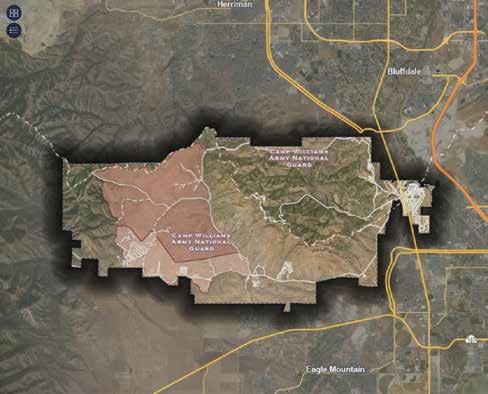
defense and in supporting emergency response, training and coordination across Utah and neighboring states,” LaFollette said.
The camp also includes classrooms, warehouses, dining facilities, a fitness center, workshop spaces and administration and maintenance buildings.
The training sessions are often the cause of the startling booms that residents sometimes hear and feel.
“Camp Williams is a primary training area for the 65th Field Artillery Brigade… as well as the 640th Regiment Regional Training Institute,” West said. “Loud booms heard are practice and live artillery rounds being fired, usually from M109A6 Paladin howitzers and M119 howitzers as
part of required training and certification. Artillery units work diligently to balance their training requirements with the impact their activities have on the populations surrounding training areas.”
To ensure units and individuals are always ready to serve, the camp receives soldiers from around the state and the nation for training in authentic and harsh conditions. “The Utah National Guard is comprised of citizen soldiers and airmen, neighbors and friends, and is proud to assist our communities, state and nation when called upon,” West said.
“We recognize the sacrifices and contributions of Guard members and appreciate the strength they bring to our region,” LaFollette said.



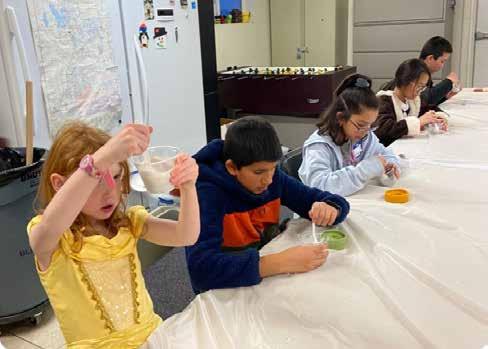
By Holly Curby | hello@hollycurby.com
Veterans Day is more than a date on the calendar. It is a living, breathing reminder of the courage and sacrifice woven into the fabric of our nation. According to the U.S. Census Bureau, there are currently more than 16.5 million veterans living in America. Each of these individuals carries a story—of service, dedication and an unwavering commitment to something greater than themselves. Each story is unique, but all are part of the same powerful legacy—one of sacrifice and honor.
I’m proud to come from a family that has served across many branches of the military:
• My grandfather, U.S. Army
• My uncle, U.S. Marine Corps
• My dad, U.S. Air Force
• My brother-in-law, U.S. Navy
As former President John F. Kennedy once said, “As we express our gratitude, we must never forget that the highest appreciation is not to utter words, but to live by them.” This quote serves as a call to action. It reminds us that true appreciation goes beyond simple thanks—it shows up in how we live, how we support our veterans, and how we uphold the freedoms they fought to protect.
• 1 in 10 U.S. adults is a veteran.
• Nearly 30% of the federal workforce is made up of veterans, continuing their legacy of public service.
• Over 45% of post-9/11 veterans say that adjusting to civilian life has been difficult—highlighting the ongoing support many need even after their service ends.
And let’s not forget: service extends beyond those in uniform. As former First Lady Jill Biden noted through her “Joining Forces” initiative, “When you go to war, we go with










you. We bear it, too.” Military families serve in quiet but profound ways—keeping households running, enduring long absences, and carrying the emotional weight that comes with every deployment. To every military family: thank you.
So what can we do to honor veterans in meaningful, everyday ways?
1. Practice Active Gratitude
Not all veterans served in combat, but all made sacrifices. When in doubt, a respectful “thank you for your service” goes a long way. Asking what branch they served in can be appropriate—but always read the room. The goal is appreciation, not interrogation.
2. Support Veteran-Owned Businesses
Many veterans transition to entrepreneurship after service. Whether it’s a local coffee shop or a clothing brand, supporting their business helps them thrive. For example, we often visit a veteran-owned eatery in our local mall— something as simple as buying a drink or a meal can make a difference. If they’re comfortable with it, consider giving them a shout-out on social media.
3. Volunteer or Donate
Organizations like Wounded Warrior Project and Fisher House Foundation provide essential support to veterans and their families. My family has cooked meals for guests staying at Fisher House and even handed out Chick-fil-A sandwiches at our local VA hospital. These small acts of kindness ripple farther than we may ever know.
4. Take Time to Listen
Years ago, I had the privilege of helping organize an event honoring Pearl Harbor survivors. More recently, I’ve sat with my dad and brother-in-law as they shared their own experiences. These conversations are priceless and ensure their stories live on for generations.
5. Live a Life Worth Their Sacrifice





As Kennedy said, it’s not just about words. It’s about honoring their legacy by being active, informed citizens who live with purpose and responsibility.
Veterans Day isn’t only a time to reflect—it’s a time to act. This week, I challenge you to do one tangible thing to honor a veteran:
• Call a family member who served
• Write a thank-you card
• Support a veteran-owned business
• Volunteer with a local veterans’ organization
Learn more on Holly’s Highlights podcast, available wherever you stream podcasts, including www.hollycurby. com. Let’s transform gratitude into action. To every veteran and every military family: Today and always, we honor you. Thank you for your service.







A growing Canyons School District initiative brings students with disabilities into general education elementary arts and music classes, fostering empathy, creativity and connection.
By Julie Slama j.slama@mycityjournals.com
When Jordan Valley fourth-grader Ava Baird and third-grader Markus Heckman stepped off the school bus at Bella Vista Elementary, their faces lit up with excitement.
They’re part of an inclusive arts program that brings Jordan Valley students with severe and profound disabilities into Beverley Taylor Sorenson arts classes at local Canyons School District elementary schools.
Bella Vista BTS teacher Christy Delaney was prepared for Ava and Markus, with two fourth-grade peer helpers ready to assist — or simply be buddies. The lessons are adaptive, ensuring every student can participate.
“There have been other times where some students will use electric scissors to cut things, so Bella Vista students get to learn too about adaptive tools maybe they’re not exposed to and they love to use them too,” Delaney said.
Earlier in the program, students built robots using recycled materials. On this day, they were painting them.
Markus, joined by Bella Vista fourth-graders Paetyn Mills and Beckham Luthi, chose red, white and blue for their robot.
“Markus suggested those colors,” Beckham said about his nonverbal buddy. “He points at what he wants or shows us with symbols and then we do it together. He has a funny sense of humor.”
Paetyn added, “I like having him here; I’m experiencing art in a different way than I would have.”
Delaney said teamwork and collaboration were part of the lesson.
“We’re working on interpersonal relationships between the students, how they can listen to somebody else’s ideas, and take everyone’s input to make a decision. Sometimes that’s a struggle sometimes in fourth grade,” she said.
How the program began
The partnership began in 2017 through the initiative of Jordan Valley BTS teacher Jonathan Hale, who codesigns and coteaches the lessons. After a pause during the pandemic, the program was revitalized and expanded.
“The BTS program offered research collaboration with the University of Utah

and helped fund it,” he said. “Our research is learning how to adapt and use art to help kids socialize. It’s important these Jordan Valley students get exposure to their peers, and they do things they typically wouldn’t do at their school.”
Originally piloted at Sprucewood Elementary with select students, the program now is offered to all Jordan Valley students across several elementary schools. Groups participate in art or music classes that match their grade level — first grade at Willow Springs, third and fourth at Bella Vista, fifth at Draper, and music for fifth grade at Midvalley.
“We only take a couple students at a time to each school, but the same kids go to the same school so they’re part of the art or music class for the year,” Hale said.
The results have been powerful.
“At another elementary, Jordan Valley students are engaged in art for 45 minutes. Typically, at our school, we get their attention for only five to 10 minutes,” Hale said. “Here, they all look at students and their eyes light up; we don’t ever see that at our school.”
Hale believes the friendships formed are key.
“They are as happy as can be and at Bella Vista, if it works out, we stay for recess because they love to play together,” he said.
At one school, when asked who wanted to walk their Jordan Valley peers to the bus, students eagerly volunteered.
“As they were walking down together, our kids were elated. They had friends around them; I’ve never seen them that happy,” Hale said.
With backgrounds in art therapy, special education, art education and fine arts, Hale
functioning and nonverbal, so they’ll communicate with iPads, which is eye-opening for our kids.”
Positive outcomes for Bella Vista students Delaney has noticed the impact on her students at Bella Vista.
“Jordan Valley students bring a new perspective,” she said. “Sometimes, they want to add something to the art project that Bella Vista students didn’t think of. This is giving them empathy and understanding.”
The adaptive strategies have also benefited English language learners.
“This benefits everybody when you add in supports,” Delaney said. “It would be neat for our students to take a field trip to their school to see their environment and supports and it gives those students a chance to show and be proud of their school.”
Hale has seen growth in partnership students.
works with his colleagues to design lessons that meet students where they are.
“There are ways to help support students, if you’re aware of them and art can provide structures and flexibility,” he said. “If students have a preference of being on the floor, we will meet them where they’re at, but not all the time. We try to help guide behaviors.”
Hale said when the lesson plan allows for sitting on the floor, many general education students join in too.
This year marks the pilot for inclusive BTS music at Midvalley Elementary.
“We’re learning how to develop music in this model as its new to this programming,” Hale said.
Despite being new, Midvalley Assistant Principal Amy Sandgren said the music program is already a success.
“Midvalley loves the collaboration with Jordan Valley School and the chance to have all students share their love for music,” she said. “Ms. (Meilina) Moore teaches fun, engaging lessons as students learn about various music genres, clap beats — and sing.”
First grade also has been added this year, with three groups visiting Willow Springs Elementary to do spin art, collages, pottery and more.
“We do about everything and adapt it as we can. We intentionally wanted to work with first grade so the kids can make a connection and build friendships. First graders don’t usually have exposure to Jordan Valley students because their development usually focuses on themselves,” Hale said.
Willow Springs BTS art teacher Mindy Van De Graaff appreciates the impact.
“All the art we’re doing is adaptive, so that everybody can be successful,” she said. “Many of the Jordan Valley kids are higher
“They’re learning their peers find as much joy out of coming to art and doing projects as they do,” he said. “They’re learning to have patience, to see everyone has different needs, and maybe to help a friend be successful, no matter what their needs are — and some kids can relate. They realize, ‘I need extra time to do something.’ They can see that in their peers so they’re speaking up now for themselves.”
Student growth at Jordan Valley
Back at Jordan Valley, the benefits are equally clear.
“It is an amazing program, because our students at our school usually don’t get to hang out with their peers,” said teacher Laura Hoggard. “This is a way for us to see how they’re acting and progressing. This helps them be ready to transition out of our school to their neighborhood schools.”
She’s seen how it affects student behavior, learning and confidence.
“Marcus is one of my students, and I can see the impact from the program at Bella Vista. He behaves a lot better and he’s more focused to learn when he comes back; he’s a role model here,” Hoggard said.
All her students love the chance to display their art.
“We have frames to mount their art. They’re proud of what they do, and they love it,” she said.
Principal Stacey Nofsinger recognizes many things about the program.
“I appreciate many things: the willingness of the principal and the teachers welcoming our students and collaborating with us; the change in environment for our students; making friends; building awareness and acceptance of individuals with special needs; understanding that all kids can learn and play,” she said. “It’s an endless list really.” l
From pop princesses to classic char-
By Julie Slama j.slama@mycityjournals.com
Juan Diego Catholic High students are ready to take center stage this theater season.
The season kicks off with the musical “Once Upon a One More Time,” scheduled for 7 p.m. on Nov. 13-15 and at 2:30 p.m. on Nov. 16. The performances will be held on the school’s main stage, 300 E. 11800 South.
Directed by Sophia Davis, the production reimagines beloved storybook princesses as they trade in their tiaras for pop anthems and newfound empowerment. Set to the music of Britney Spears, the show delivers a fresh take on classic tales with humor, heart and energetic choreography.
“In this dazzling jukebox musical, the fairytale heroines we think we know, Cinderella, Snow White and more discover a whole new world when a fairy godmother gifts them ‘The Feminine Mystique,’” Davis said. “‘Once Upon a One More Time’ is a glittering celebration of sisterhood, self-discovery and rewriting your own story, proving that ‘happily ever after’ is only the beginning.”
It is followed by the show, “Rotten Ap-
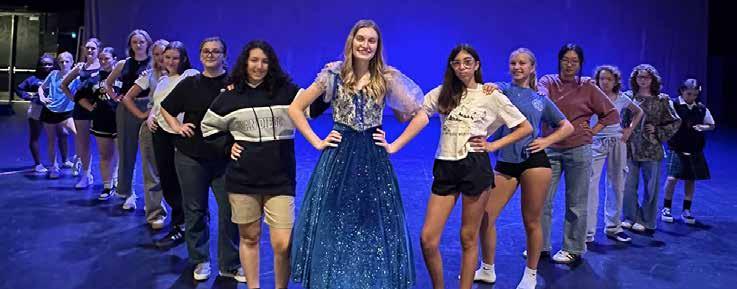
ples,” by Tracy Wells, a playwright known for her extensive work with youth theater. It will be performed March 19-22, 2026 in the school’s new Black Box Theatre.
This play also dives into the world of fairy tale characters, but from a different angle — revealing the reality behind the “happily ever afters.” Davis said the humorous and reflective drama offers audiences a chance to see their favorite characters from a
fresh perspective.
“(The) classic storybook figures find themselves tangled in a clever, comedic twist that turns their perfect endings upside down,” she said. “‘Rotten Apples’ proves that sometimes the sweetest stories can have a tart bite.”
Also in March, the thespians will compete in the region theatre competition with “Selfie,” a one-act play by Bradley Hay-
ward. The 30-minute piece centers high school seniors navigating the struggles of identity, peer and parental expectations, and the search for belonging in the digital age.
“The play captures the challenges of growing up today while reminding us that behind every ‘perfect picture’ is a real story waiting to be told,” Davis said.
For ticket and show information, go to the school’s website, skaggscatholiccenter.org. l






Interactive exhibits, student leaders and curious minds turned out for the 11th annual event.
By Julie Slama j.slama@mycityjournals.com
Amid thousands of students during the day and hundreds of families at night, an electric energy pulsed through the crowd at Utah STEMfest — and no lab coat was required.
Kids felt literal static electricity as they placed their hands on a plasma ball at the Clark Planetarium booth while others explored how electric currents work at a Rocky Mountain Power display. To cool off, they plunged their hands into insta-snow demonstrated by SheTech student leaders or touched sea stars, sea turtle shells and other marine life specimens at the Loveland Living Planet Aquarium table.
Three-year-old Poppy, brought along her 1-year-old sister, Delilah, and her dad, Jed Hall, eager to dive into the hands-on experiences available at the Mountain America Expo Center in Sandy.
“We like to do experiments at home, so I’m trying to foster a love of STEM in my little girl,” Hall said. “I hope she can

Summit Veterinary Urgent Care offers compassionate, comprehensive medicine without the need for an appointment. Our kindhearted staff is dedicated to providing prompt and thoughtful care when your beloved pet needs immediate attention.
Our proprietors, Dr. Taylor Howard (DVM) and Cassie Czerny (CVT), founded SVUC in 2024 and are passionate about providing same-day care at an affordable price.
From broken nails to surgeries and life-threatening emergencies, we treat it all. Anal gland expressions? We love them! Call for a same-day appointment or just come on in. If your fur baby is just a little off and you don’t want to wait, we’re here for you. Even if your baby hates going to the doctor, no one has a knack with spicy kitties like Dr. Howard.
Small car and a big dog? No problem. We offer transportation for those who need it. Not only to and from your home, but to an overnight facility should your pet need extended care as well.
On-site, top-of-the-line laboratory testing, radiology and advanced imaging get us answers without having to wait, so we can get a diagnosis and start treatment as soon as possible. Our fully equipped surgical suite provides advanced surgical care in a comfortable and sterile environment.
With our extensive in-house and online pharmacy, you can get Fido feeling better quickly,
have a better understanding of the world. I want her to develop a love of learning while she’s young so she will keep it up when she’s older.”
It wasn’t just kids who were learning — volunteer Dannette Rose said she was helping because she wanted to expand her own STEM knowledge.
“I like to learn all kinds of stuff when I help; it’s a good opportunity to learn and explore,” she said.
Rose was assisting Denise Taylor, a Utah 4-H STEM and strategic partner with Utah State University. Together, they guided attendees through the Utah 4-H night sky star dome, encouraging them to look to the heavens.
“It’s important kids get exposed to lots of different things because STEM is in everything we do,” Taylor said, listing a vast array of 4-H clubs which all include STEM. “We just need to point it out to students. They can garden, and there’s science behind the soil and the growing process. They do robotics and we can talk about coding. They read Harry Potter and explore potions and wands and learn about chemical reactions and magnetic fields. When we go into elementary schools, sometimes kids say, ‘I don’t do STEM,’ but they don’t realize our world is engrossed in it, and it will be a big

without extra stops on the way home.
We are proud to be a privately owned and woman-owned business. Supporting and caring for Salt Lake Valley pets and their amazing families. Our team is well-trained and dedicated to helping your pets live their healthiest lives in a clean, comfortable environment while still offering services at a reasonable price. Our same-day services are comparable to a regular veterinary clinic, and we will always provide an estimate and work within your budget without judgment.
We understand unexpected medical expenses can add up quickly. Therefore, in addition to keeping our prices as low as possible, we offer financing options to further help ease the burden.
We will work with your regular vet and communicate all treatments, plans and medical records so your baby can get back on the road to health and wellness.
We welcome everyone! Two-legged or fourlegged, furry or not. We provide care Monday through Friday from 8 a.m. to 5 p.m.
With the growing number of pets in Salt Lake City, getting in to see your vet the same day can be difficult; that’s where we come in. We are trustworthy, caring, knowledgeable and experienced. Pet problems don’t wait for an appointment, and now you don’t have to either.
Be sure to follow us on Instagram: @summitveturgentcare
part of their future and is what they can do.”
Tami Goetz, director of the Utah STEM Action Center — the organization behind the 11th annual event, agrees.
“I have seen students trying to figure
how to balance their love of STEM with other interests and passions,” she said. “My advice to them has always been that they are lucky because STEM overlaps with so many other education and career paths.” l


Erin Longacre fills the state school board seat vacated by Molly Hart, who became state superintendent.
By Julie Slama j.slama@mycityjournals.com
From rooting on middle school mountain bikers to making statewide decisions, she’s “all in” when it comes to students.
As one of four mountain biking coaches for Draper Park Middle School, Erin Longacre spends hours surrounded by energy, passion and dirt trails, cheering middle schoolers as they take on nerve-wracking racecourses.
“It is so much fun,” she said. “These kids, I don’t know how they line up and not just crumble at the starting line, because it is high energy, high intensity and man, the nerves would get me. But they’re strong un der pressure. I’m proud of them.”
Longacre’s coaching role, she laughs as she describes it: “I’m mostly a cheerleader. I love cheering on the kids, but I do need to know a little bit. As long as you can ride a bike, you can pretty much coach at the mid dle school level.”
That spirit of engagement is what de fines her approach to everything she does and Longacre admits, she does a lot.
Longacre is a substitute teacher of sev en years; a crossing guard for Draper City;

Utah State Board of Education member.
“I’ve had a passion for education for some time now,” she said. “When this opened up, I was prayerful about it and I thought, ‘OK, I’ll put my name in and we’ll see what
love that about Molly and people on the board have great respect for one another,” she said. Far from a distant policymaker, Longacre plans to stay rooted in classrooms and community conversations.





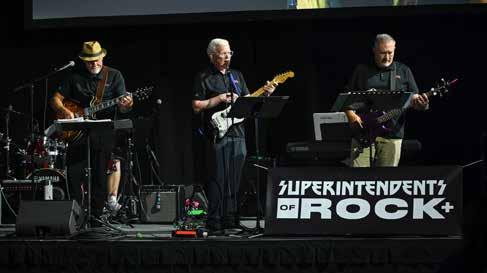

From massages to mental health strategies, the conference blended fun, purpose and professional learning for Utah’s educators.
By Julie Slama j.slama@mycityjournals.com
During a break between sessions at the Show Up for Teachers conference, Altara Elementary fourth-grade teacher Clifford Lowe stopped by the STEM Action Center booth—one of 120 offering curriculum ideas, resources and giveaways.
“The STEM Action Center booth was awesome; I got some cool stuff from them that I’ll incorporate into my classroom,” said the Canyons School District dual immersion teacher. “The community here is really big in helping and supporting teachers and I’ve been networking with teachers from other districts, getting to know things they’ve done.”
Lowe also took advantage of a free massage and a coconut Creamie while gathering ideas for his classroom’s calming corner.
The full-day event, at the Mountain America Expo Center in Sandy, featured keynote speakers, 40 breakout sessions, and an exposition hall filled with businesses and organizations celebrating and supporting teachers. Session topics included classroom engagement, personal finance, nutrition and sleep, stress management, leadership, and conflict resolution.
Afternoon keynote speaker Ron Clark, founder of the Ron Clark Academy in Atlanta, addressed the crowd, while local authors signed books and the “Superintendents of Rock”— including Jordan School District Superintendent Anthony Godfrey—performed live.
Attendees earned re-licensure points from the Utah State Board of Education or could opt for university credit from South-
ern Utah University. The free event was sponsored by The Clark & Christine Ivory Foundation, the Robert H. and Katherine B. Garff Foundation, Capita Financial, Zions Bank and Western Governors University.
The exposition hall featured giveaways and discounts from organizations including Thread, Chatbooks, Beehive Meals, University of Utah Wellness Hub, RC Willey, Operation Literacy, Salt by Sabrina, Albion Fit, Symbol Arts, Felt Right, Beddy’s, Hogle Zoo and the Utah Shakespeare Festival.
At the BYU Arts Partnership booth, educators learned about the Native American Curriculum Initiative.
“It’s an initiative that partners with the eight sovereign nations in Utah to co-create authentic and accurate lesson plans that teachers can teach to students in their classrooms,” said program coordinator Brenda Beyal. “We go to these sovereign nations and ask them, ‘What would you like the children of Utah to know about your tribe?’ All eight sovereign nations have said they want people to know they’re still here, they’re thriving, they’re resilient, and they continue to work to better their communities.”
Each nation then wanted to spotlight other points: the Paiutes highlighted their fight for federal recognition, the Northwestern Band of the Shoshone shared traditional songs, and the Navajo Nation emphasized the historical “Long Walk.”
“All these nations have stories or things they want people to know and we use the arts to help tell those stories — and teachers can use the lessons we’ve created on our website along with podcasts and other resources,” she said.
Nearby, the Special Olympics Utah booth promoted Unified Champion Schools. Boston Iacobazzi, college-growth coordinator, said at least five colleges, 85 high schools, 25 middle schools, and 35 elementary schools par-
ticipate in programs pairing students with and without disabilities.
Special Olympics Utah CEO Scott Weaver said teachers were enthusiastic about the inclusive programming.
“We have gotten some positive feedback from teachers who currently have the program,” he said. “We just had a teacher in her second year rave about the leadership
program with youth engagement and a lot of these teachers see the value for their students, both for special education and regular ed students. It’s becoming a regular part of the school culture from reading together in elementary to playing sports, taking classes and becoming school leaders together. It’s rewarding to hear how inclusion is becoming part of the schools’ cultures.” l
SINGLE WASH $24
UNLIMITED WASH CLUB: $40/MONTH
SINGLE WASH $12
UNLIMITED WASH CLUB: $22.50/MONTH
SINGLE WASH $20
UNLIMITED WASH CLUB: $35/MONTH




Following the withdrawal of candidate Jaren Turner, Mike Green and Tasha Lowery were certified elected and their race will not be on the November ballot.
By Mimi Darley Dutton m.dutton@mycityjournals.com
Three candidates were running in the Nov. 4 general election for two fouryear at-large Draper City Council positions, but one dropped out, leaving that race canceled before the ballots were printed. That’s what happens when the number of candidates equals the number of open seats.
Current councilmembers Mike Green and Tasha Lowery were running again for their seats against candidate Jared Turner. According to Draper City Recorder Nicole Smedley, Turner withdrew from the race Sept. 15, citing personal reasons.
Smedley realized state law allows a race to be removed from the ballot within a certain window of time prior to the election, so she quickly contacted the Salt Lake County Clerk’s office who administers Draper City’s elections. By pulling that race off the November ballot, the County Clerk’s office estimates the city will save approximately $40,000.
Utah State Code states, “…if a municipal body passes, no later than 20 calendar days before the day of the scheduled election, a resolution that cancels the election and certifies that…the candidates who qualified for the ballot are considered elected.” Green and Lowery were certified elected at the Oct. 7 council meeting after a resolution canceling the race for the two four-year at-large council seats was passed unanimously, including votes by Lowery and Green.
“It’s so weird to vote on that yourself,” Green said.
Green said he was stunned when he heard the news Sept. 15 that the race was over even before the November election
took place. “I didn’t believe it so I asked to see the document (of the third candidate’s withdrawal). I was in a little bit of shock,” he said. But shock quickly turned to relief. “Now I can focus on the issues ahead of us. We don’t have to worry about the campaign. It’s a time-consuming thing, about 20 hours/week if you do it right. You’ll knock doors every night or be at an event every day for it,” he said.
Green is looking ahead to the next four years. “The focus is going to be to continue to do the right things for The Point, the land vacated by the prison. I want to try to acquire more land on the mountain to preserve more and build more trails. I’d like to get some infrastructure taken care of for public safety such as roads that need work around town and another fire station on the west side. Then I want to focus on getting a community center done in the Town Center zone, and all that time keep taxes low. We’ll see what we can do,” he said.
Lowery was also surprised that the race was over before the election even happened. “I hope residents know that even though I didn’t have a campaign, I’m happy to talk with them and I’m accessible all the time, not just during the campaign. They can call, email, text or reach out over social media. I don’t want to just hear from them when I’m running for office,” she said.
She had bought her yard signs, assembled a campaign staff and volunteers, had mailers planned and ads ready to go.
“Campaigning is an important part of being elected, to touch base with people and hear what they’re worried about as well as what they’re happy about. I was fully immersed in doing that part of it,” she said. Because she thinks those aspects of campaigning are so important, she offered to knock doors with Mayor Troy Walker for his race to be mayor again.
“This has been such a great experience for me, so to be able to serve once again is an honor and a privilege,” she said.
As for her focus in the next four years Lowery said, “I don’t think you have to go

Tasha Lowery was certified elected after the third person in a Draper City Council race withdrew, leaving two candidates for two seats. Lowery said despite the fact that her campaign is over just as it was ramping up, she hopes people won’t hesitate to reach out to her with concerns. She was first elected in 2017. (Courtesy Draper City)
far to see Draper is well-run and organized and we’re doing well. I think we’re going to keep focusing on more of the same,” she said. She mentioned a potential purchase by the city of as many as 76 acres within Corner Canyon. “The city is considering purchasing it to settle a claim involving access to the property,” City Manager Mike Barker said.
While already declared elected, Lowery and Green will take the Oath of Office with other election winners in early January at City Hall in accordance with when their current terms expire.
This will be the third four-year term on the council for both. They ran in 2017 and were sworn in in January 2018 for the first time.
Items remaining on the Nov. 4 General Election ballots are the mayoral race, a two-year at-large city council position,

Mike Green was certified elected in October after a candidate suddenly withdrew from the race. He said he was stunned it was all over in September, but also relieved, because campaigning is time-consuming. He and Tasha Lowery will begin their third four-year terms on the Draper City Council in January 2026 when they take the Oath of Office. (Courtesy Draper City)
and the Aspen Peak School Board race for the segment of Draper (a portion of SunCrest) that is in Utah County.
Ballots will be mailed beginning Oct. 14. Completed ballots must be received by the County Clerk’s office by 8 p.m. on Election Day, not just mailed by that dates as was the law in years past. Draper City Hall will serve as an in-person voting location as well as a drop-box location for ballots. Draper City Hall has a ballot drop box in the south parking lot. Official voting centers and drop boxes close promptly at 8 p.m. on Election Day, Nov. 4.
“Legislation just changed,” Smedley said. “I think the most important thing in this election is that vote-by-mail ballots need to be in the hand of the County Elections Office on Election Day.” l

Editor’s note: Tasha Lowery’s responses to our Voters Guide questions were inadvertently left off last edition. We include
Sourced directly from our readers
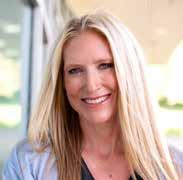
Do you believe current property tax revenue is being used effectively? How so?
Yes- current property tax is being used very effectively in Draper- it is primarily used to cover public safety expenses. In an ideal world, police and fire would be fully covered by property taxes as it is the most dependable source of revenue. In reality, we use sales tax revenue to close the gap and make sure public safety is fully funded.


Thinking about fiscal responsibility—what values should your local budget reflect? How do you plan to balance those values?
Our local budget must be balanced, focusing first on core services like public safety, drivable roads, and essential services like waste management, while limiting non-essential programs. Taxpayer dollars must be spent efficiently and transparently, ensuring every dollar delivers real value to the community. Long-term fiscal discipline requires limiting debt, avoiding tax increases whenever possible, and prioritizing savings for future needs.
What systems would you support to hold local officials accountable when transparency standards aren’t met?
Transparency has been a top priority for me since day one. I summarize every single meeting and post it publicly so residents know how and why I voted as I did. I respond to all emails and meet with anyone who requests a meeting. I welcome constructive criticism and I am fully committed to honesty, and accountability, even when discussions are difficult. I sometimes tell people things they don’t want to hear, but I would much rather have clear communication and all be on the same page than make false promises or expectations.
What is your stance on local government cooperation with ICE?
What steps would you take to ensure that seniors can age in place affordably and safely in our community?
Local governments are charged with providing services like responsive and high quality public safety, good roads, functioning utilities, and recreational opportunities; diverting resources to federal immigration enforcement pulls us away from our primary responsibilities and we simply don’t have the resources. Ultimately, immigration enforcement is a federal responsibility, and when local governments step into that role, we risk legal conflicts and blurred lines of accountability. We also strive to have positive relationships with all residents so if a home catches on fire or grandma has a heart attack or they are victims of a crime, all residents see local law enforcement as a safe place to go to for help. In the end, local tax dollars and staff time should remain focused on community priorities within the city, rather than funding or duplicating federal enforcement efforts.
Seniors are an amazing part of our Draper community. We are glad to have a beautiful senior center and to support programs like Meals on Wheels. We offer programs through our Rec Department such as snow shoeing to help get more people outdoors on easy hikes, even in the winter. We also have an active historical society, historic preservation committee, and a local history museum. We have many paved walking paths throughout the city for easy and safe exercise, away from crowds and traffic.

























By Julie Slama j.slama@mycityjournals.com
Inrecent years, the Canyons School District has launched a major effort to modernize its 43 school libraries, investing $1.2 million into refreshing aging collections to ensure they’re supporting literacy, inquiry and student engagement.
The Districtwide push aims to reflect the diversity of today’s students, including the 4,000 multilingual learners enrolled in Canyons schools. Many collections feature books in multiple languages, aligning with the district’s dual-language immersion programs. When the new Glacier Hills Elementary and Peruvian Park Elementary opened, they received brand-new collections. The rebuilt Union Middle School saw a major library investment when it reopened.
A 2022 review found Canyons’ elementary library collections were, on average, 17 years old, prompting the upgrade.
These improvements represent more than just new books. They reflect a growing recognition that libraries are dynamic, student-centered spaces that promote equity, elevate diverse voices and spark curiosity, said Superintendent Rick Robins.
Robins, who championed the transformation, recently was named Administrator of the Year by the Utah School Librarian Association.
Robins said he was honored by the recognition, but emphasized the credit belongs to the District’s educators and librarians.
“It’s more than a reflection on my leadership,” he said. “It’s a reflection on all the great teachers and teacher librarians that we have in Canyons School District. They’re dedicated to literacy and access for our students. They’ve done great work with updating our libraries and helping students find books that they see themselves in, that they can relate to,
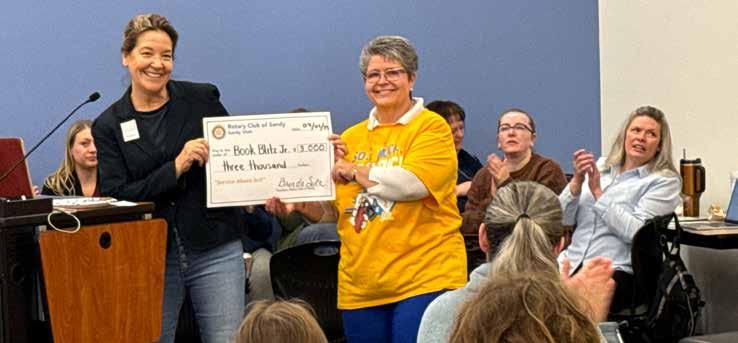
at the same time making sure that students have safe books that are age appropriate.”
His love of reading stemmed from the arrival of a bookmobile in his rural hometown.
“When the bookmobiles came, I was always excited to go see the newest books,” he said. “Now, these students can walk into the library and experience the tactile feel of a new book to check out. That’s pretty special.”
Canyons School District Library Media Specialist Gretchen Zaitzeff said the District now offers the strongest school library collection in the state.
“Rick is an excellent example of an administrator who understands the value of libraries in supporting literacy,” she said.
Zaitzeff was also recently honored with the Literacy Champion Librarian award at the Love of Reading conference. She oversees the district’s 368,525 physical books and a digital collection of nearly 71,000 titles.
“It’s a recognition for our ongoing efforts to support our students,” she said, pointing to programs such as Book Blitz,

where middle school students read selected titles and compete in trivia-style challenges. The elementary version, Book Blitz Jr., is now in 23 of 28 schools.
“Reading is the most important academic skill that a student can acquire, and any effort that we can make to help support the student in learning to read and then practicing reading and learning to love reading is the most important work we could be doing,” she said.
Zaitzeff believes libraries are essential places for students to practice reading outside the classroom.
“You have to practice reading, so that’s what a library is for. It’s like a football field or basketball court. It’s where you practice reading, with a coach — the librarian — and all the equipment —books — you could need,” she said. “If you like earthworms, I got books on earthworms. If you like rockets, I got books on rockets. Magic? I got books on magic. Taekwondo? Got that too. In the best libraries, we have them in multiple languages and formats to help all stu-
dents become better readers.”
Beyond books, Canyons’ libraries support the curriculum, provide makerspaces, host author visits and teach research and media literacy skills.
“I can’t think of a skill that’s more needed than to be able to tell the difference between facts and opinions and accurate information and misinformation,” she said.
Zaitzeff’s love of reading stems from childhood.
“I found libraries to be a welcoming environment that was a really great place to learn and grow, and there was just an excitement about books,” she said.
Now, she and the rest of Canyons’ dedicated team of K-12 share the same excitement with 31,000 students.
“Our K-12 librarians, they’re super dedicated to students,” Zaitzeff said. “They are supportive of teachers and classroom instruction. They work hard to make libraries welcoming and safe spaces for students.” l















“The devil’s always in the details,” Mayor Troy Walker said.
By Mimi Darley Dutton m.dutton@mycityjournals.com
Draper City legal counsel Bruce Baird called the process of reaching an Interlocal Agreement with The Point of the Mountain State Land Authority (PMSLA) “long and tortured.” The Point is the 600 acres of state-owned land that falls within Draper City limits, where the state prison once stood. Mayor Troy Walker said he “agreed 100%” with Baird’s assessment.
The agreement was finalized in September after a year of negotiations. “I can’t tell you this agreement is perfect, but I believe this is the best agreement we can get at this time,” Baird told the Draper City Council. He has been representing Draper City in negotiations with PMSLA since before a development agreement for Phase One of The Point was signed in December 2022.
Walker said it’s a “complex situation” and the Interlocal Agreement is all about infrastructure. “The state was trying to put in the backbone infrastructure which it’s required to do under the development agreement, but since the backbone infrastructure
gets turned over to the city, we had to make sure we’re getting infrastructure we could maintain and operate,” Walker said.
According to the mayor, part of the difficulty came because the state hasn’t done anything like this development before. “The visioning, the planning, it’s unprecedented. It’s the rubber meeting the road part that takes time and effort,” Walker said. Additionally, The Point’s plan has different infrastructure than the city would normally approve such as roads and intersections. “Part of it was getting our heads around what they wanted to do, and even though it’s not our standard, it’s a standard that’s safe. It took a while, but we got there,” he said. The agreement also outlines water, parks and public safety. “We kept our standards on culinary water and stormwater. The main purpose was making sure the roads and the under-bones that make them last were done correctly,” Walker said.
At their Sept. 16 meeting, the council approved both the Interlocal Agreement and an accompanying consultant agreement presented by Baird. He told the council the point of the agreement is to make sure the city doesn’t get infrastructure that fails as has happened with other projects and to make sure costs don’t come from the city’s engineering department who has
been carrying the load up to this point.
“Our city engineer, Scott Cooley, did a fantastic job looking out for Draper’s interests,” Walker said. As a result of the negotiations, an independent third-party consultant has been hired to enforce the terms of recognized design and safety standards. “PMSLA is paying for the consultant, but their responsibility is to the integrity of the project and the documents that govern that, including safety and design standards. Draper has had a couple experiences where things were well designed but not well built, and that shouldn’t happen here,” Baird told the council.
According to The Point’s Don Willie, Methods Consulting is the firm retained in accordance with the Interlocal Agreement. “They are under contract and actively supporting our project,” he said.
Walker serves on the seven member PMSLA board made up of state legislators, agency executives, local elected officials and business leaders. He was heavily involved in the negotiations. The mayor said some people wonder if it’s a conflict of interest, but that’s not the case. “I can only make decisions the city council authorizes me to make. On The Point side, I wouldn’t be voting for anything my city wouldn’t authorize me to do. If my city told me not to make the deal, I wouldn’t be voting on
it. I think the thing I bring to this the most is I’ve been involved with The Point development my entire 18 years of public service,” he said.
Draper City will also provide public safety for The Point, including fire and police, but specifics have yet to be ironed out. “It commits us to providing public services. It doesn’t define a level, just services we would normally provide. We’ll meet the needs as it goes along,” Walker said.
The Point held an infrastructure groundbreaking ceremony in December 2024 and that work continues through 2025. Walker expects vertical construction to begin in the fourth quarter of 2026 starting with apartment buildings anchored by retail on the ground level. The Point’s Event Center, one of the first buildings that will come out of the ground, is already funded. “They sold bonds in the commercial market to build that. They sold every dime they wanted to sell and that’s exciting. Private investors believe this has really good potential,” he said.
According to Walker, The Point is talking about selling 50 acres for ownership housing, something that wasn’t in the state’s original plan, but something he supports. “The goal was for the state to have a revenue stream over time to help pay

















for the brand-new prison they built. This whole project was done so the state could get a revenue stream from this property, and they wanted to control it and make it big,” he said.
Baird used the words “damn good”
in describing the Interlocal Agreement to the city council. “Your mayor has used his trademark style in helping them recognize they needed to fly right on these. As long as you’re willing to play hardball, I think you’re going to get what you need,”
Baird said.
Because Walker has been talking about The Point for nearly two decades, he feels like it’s been slow-going.
“It’s taking longer than I ever thought it would, but there are so many factors…
the economy, interest rates and construction costs,” Walker said. “The Point is the future economic center for the city of Draper. Getting it off the ground and moving forward is to our benefit. It’s our future growth.” l

The recent shooting of Charlie Kirk was a wake-up call for Americans who value free speech. What drives someone to fear opposing views so deeply that violence feels justified? If we want to cool our nation’s overheated politics, each of us can start with three changes.
1. Don’t call names or label the other side. Our country was founded on the belief that open debate makes us stronger. The Founders argued fiercely when crafting the Constitution—and that was healthy. But when disagreement turns into name-calling, the conversation collapses. History shows that dehumanizing language can fuel tragedy; in Rwanda, propaganda that labeled the Tutsis as “cockroaches” helped spark genocide.
Calling people “evil” or “dangerous” never changes minds. Respectful discussion does. Express your beliefs firmly but without vilifying others. The moment you deny someone dignity, your argument loses power. One way to rebuild civility is to teach debate skills in middle school and high school classrooms so the next generation learns how to disagree productively.
2. Listen more than you speak. None of us is right all the time. Listening with empathy to those who see things dif-



ferently can preserve friendships and strengthen our communities. Try this: ask someone with an opposing political view to explain their perspective for 5-10 minutes. Repeat back what you heard, thank them, and resist the urge to argue. It’s hard—but it’s how understanding begins.
During my 12 years on the Salt Lake County Council, I’ve served on a body that’s often split almost evenly between Republicans and Democrats. We debate passionately, sometimes disagree strongly, yet still shake hands afterward. We recognize that each member represents different constituents and experiences. Even when votes fall along party lines, mutual respect keeps us working together. I’m proud of that example of civil governance.
3. Recognize how you’re being manip-




ulated. Social media algorithms are designed to provoke emotion, not inform. Once a platform detects your political leanings, it floods your feed with fear or anger-inducing content to keep you scrolling—and advertisers paying. Limit your time online. Keep in mind that each side is driven by this algorithm that fuels the flame of conviction. We question how the other side can be so out of touch, yet they simply don’t see what we see. Those on the other end of the political spectrum have never been shown the version of the story we know. Perhaps we are both right, but perhaps we are both wrong. It’s time to pause before the contempt destroys our country.
Cable news isn’t much better. Filling 24 hours of airtime pushes networks to amplify outrage and tailor coverage to partisan audiences. Try this experiment: if you watch a story on Fox News, switch to MSNBC for the other perspective, or vice versa. The truth may lie somewhere in between.
As we navigate the future, it’s important that we put down our phones, turn off the TV, and talk to real people. Human connection improves mental health and builds relationships. When the political climate feels toxic, step away from social media
and find a friend to visit with—no debating required.
Our democracy depends on citizens who can disagree without demeaning, listen without shouting, and stay informed without being manipulated. By resisting name calling, listening with empathy, and unplugging from outrage, we can help lower the temperature, strengthen our communities, and set an example for the next generation that is watching us closely.















It’s not a good sign when a season has its own mental disorder, but here we are, entering the dark, cold, abysmal days of post-Daylight Saving Time when Seasonal Affective Disorder destroys all joy. Darkness descends like a roiling thunderstorm in a fantasy novel, erasing all sunshine and leaving us cowering in the cellar.
My husband thinks I’m dramatic, but I tell him to stop calling me names, as I drape across the fainting couch, gently dabbing my tears with a silken handkerchief.
Anyway.
This year, Seasonal Affective Disorder has been changed to Seasonal Affective Despair as we watch the nation’s slow descent into malevolence and madness. Night falls immediately after lunch, pajamas are my goto wardrobe and my serotonin levels drop as quickly as my faith in humanity.
As we move toward winter, light deprivation should be considered a national crisis. Maybe we need a Vitamin D shot mandate or, at least, red light therapy lamps to replace all street lighting. Utah recently eliminated fluoride in the water; could we add a dash of Xanax?
I know there’s a fine line between hibernation and hiding, but maybe the bears have it right. Spend the summer and fall eating ev-

erything in sight, yank fresh salmon right out of the river, compete for the World’s Fattest Bear and then sleep until the sun returns.
Therapists recommend regular exercise, a healthy diet and sufficient sleep to improve mental health and reduce Seasonal Affective Despair symptoms, but nobody listens to their therapist; otherwise, we wouldn’t be in this national mess.
Someone on TikTok suggested organizing craft projects to get me through the dark months, but my closet is already full of discarded creations, including featherless pinecone turkeys and the unfinished baby blanket I was making for my first grandchild (who is now 21).
As I sorted through a tangle of thread from my last embroidery project and a cubic pound of glitter I bought when I thought making glitter angels with the grandkids was a good idea, I decided starting something
new wasn’t a good idea. Plus, I still have glue gun scars from my Halloween projects.
Maybe I can spend the next few months snuggled with a book by the fireplace (if we had a fireplace), enjoying a bowl of minestrone (just kidding, my husband hates soup) and trying to live with someone who hates soup.
I’ll be poppin’ melatonin gummies like, well, like gummies, and giving it my best to be optimistic in a season created when a god of the underworld kidnapped a young girl and held her hostage for six months. On a coincidentally bright note, pomegranates are back in stores.
At least Thanksgiving is coming up, when I can get my emotional support food: mashed potatoes.
As we move toward the end of the year, November offers an invitation to look back at the previous months to see…nope…never mind. Don’t do that if you’re looking for sunshine and rainbows. In fact, maybe throw your phone in the Great Salt Lake (if it still had water), disconnect from the internet, delete your social media pages and go off-grid until May.
Mentally prepare yourself to spend several months trapped in a home with kids, or grandkids, who won’t stop saying, “6-7” or muttering Italian Brainrot nonsense.

Maybe this year’s Seasonal Affective Despair will be the start of my superhero origin story. When the light finally returns, I’ll stumble into the sunshine, wearing wrinkled pajamas and gripping a glue gun, ready to battle the forces of evil.















